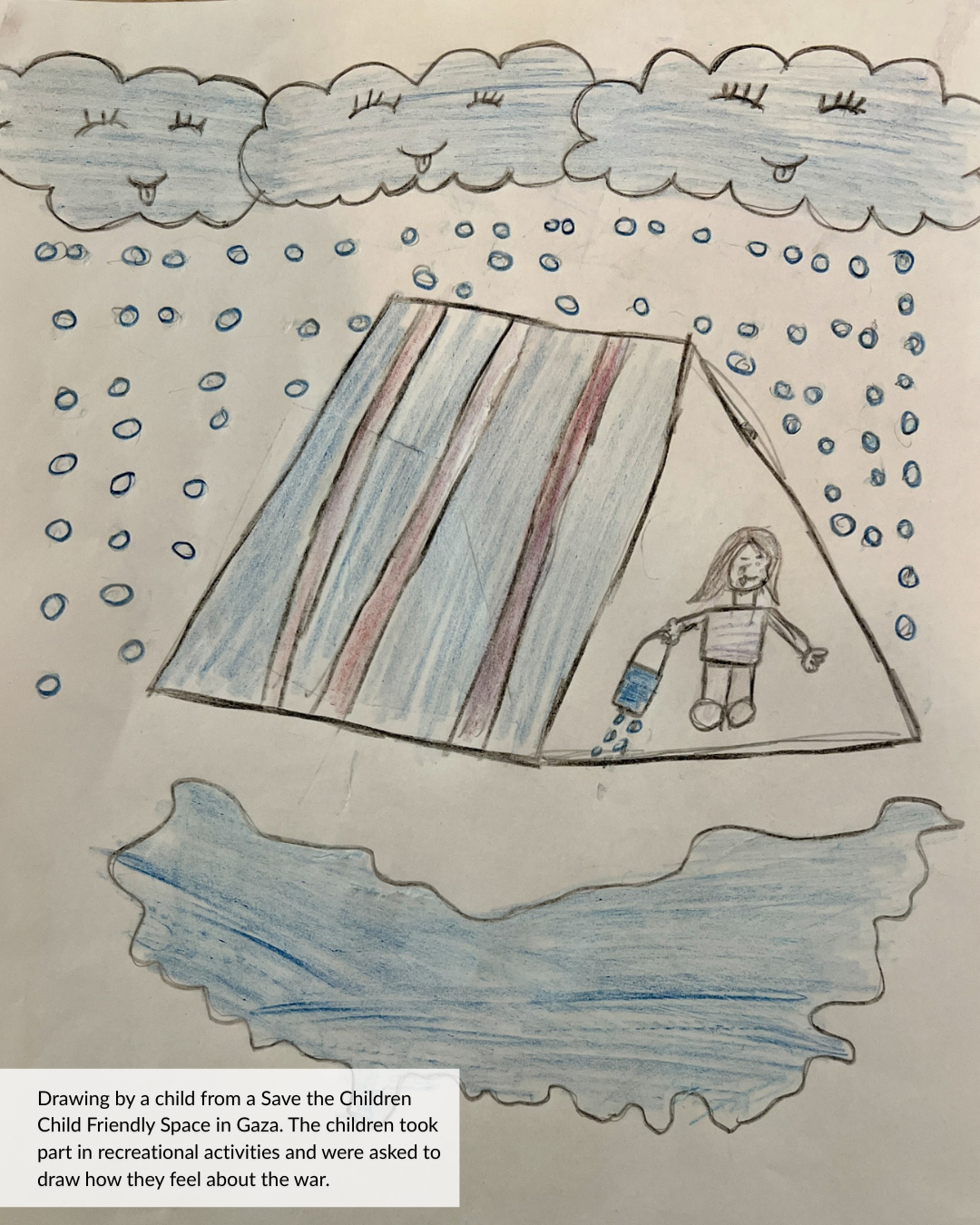
Image: Drawing of the rain from one of Save the Children's Child Friendly Spaces in Gaza
GAZA CITY, 18 November 2025 – Children in Gaza are sleeping on the bare ground with no shelter, in flimsy shorts and t-shirts that are sodden with sewage water after their tents flooded in a weekend of heavy rains, putting them at risk of disease, Save the Children said.
Hundreds of tents and makeshift shelters were flooded on Friday, affecting more than 13,000 households, according to the UN, as Gaza’s harsh winter conditions begin.
With the sanitation systems across Gaza collapsed after two years of Israeli bombardment, siege and aid restrictions, rainwater no longer drains properly and is now mixed with sewage that has flooded people’s tents, soaking mattresses, blankets, clothes and even bags of food.
With many children having no shoes or change of clothes and the sanitation system attacked and overwhelmed, the threat of disease is looming, Save the Children said.
Shurouq, Media Manager at Save the Children in Gaza said:
“On Friday, people woke up and found themselves submerged in sewage water. We’ve had two years of living in tents, and they are already worn out; they cannot withstand the wind, or the rain.
“I saw a woman with a six-month old baby, carrying her running around screaming “Where shall I go?”"
According to data from the shelter cluster of aid organisations in Gaza, more than two thirds of Gaza’s children – about 700,000 – are exposed to similar risks, living in tents that are falling apart after two years of bombardment and displacement.
Since the announcement of the first phase of the peace plana month ago, 19,000 tents have entered Gaza, as well as 276,000 tarpaulins, according to the shelter cluster, but no timber or tools have entered due to restrictions on what Israeli authorities consider “dual-use” items. Over 63,400 tents, 803,600 tarpaulins, and 278,000 bedding kits remain stuck at the border,
Without tools and equipment, people are unable to start repairs to homes and many are scared to move due to unexploded ordinance, already causing child casualties, or the fear of further airstrikes.
With over 81% of buildings damaged, most people are still sheltering in whatever is left of tents used over the past two years, sewing blankets or any other materials they can find to patch up holes.
Despite the past month seeing more items in the markets, blankets and mattresses are almost nowhere to be seen, Save the Children said. New clothes are also near-impossible to come by, with children still wearing summer clothes of shorts and t-shirts, and most of them barefoot. With families desperate for the basics to survive, they spend what little they have on food rather than new clothes, Save the Children said.
With children in Gaza already at great risk of malnutrition and illnesses like diarrhea and pneumonia, cold temperatures can be deadly. At least 14 children, including newborn babies, died of hypothermia in the past two winters, according to Gaza’s Government Media Office.
Ahmad Alhendawi, Regional Director for Save the Children in the Middle East, North Africa and Eastern Europe, said:
“Children and families have woken up submerged in sewage water. For the third winter now since the start of intense Israeli bombardment in October 2023, they are desperate not just for a lasting ceasefire but for secure, safe and warm places to sleep.
“These tents that have been reduced to wrecked bits of material are not able to withstand the wind and the rain and are not able to protect children from illnesses. We have already seen at least 14 children die due to hypothermia over the past two winters – this cannot happen again.
“Over a month ago, world leaders convened to witness the signing of an agreement promising a much-needed aid flow and an end for this unimaginable suffering. This winter the agreement must turn into a lasting ceasefire, the flooding of aid into the Strip, and Gaza must be able to finally wake up from its nightmare.”
While Save the Children still has items waiting at the border, in the coming months the aid organisation plans to distribute locally procured winter household items and shelter kits, including mattresses, sheets and covers, pillows, pillowcases, blankets, mats, tarpaulins, and other winter items, as well as over 2,000 kits of winter clothing for children.
Save the Children is also distributing US$2 million in cash assistance to help families buy what they can for winter in the market. Save the Children hasn’t had its own supplies enter Gaza since March.
ENDS
For further enquiries please reach out to: